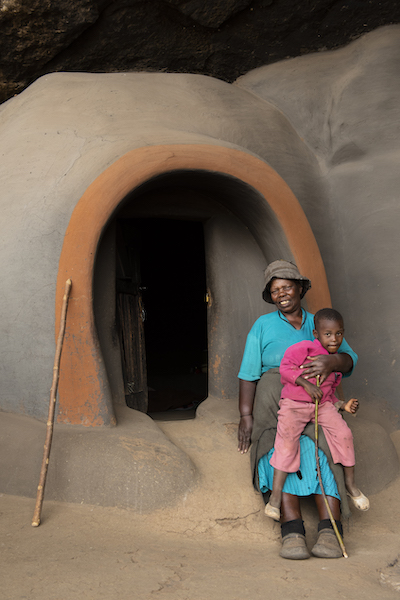The tall, deep rock overhangs that characterise the highlands of Lesotho have provided shelter to humans since time immemorial. In prehistoric times, these spacious natural refuges are where San (Bushman) families would huddle together around a fire to eat and exchange stories, while their shamans performed mysterious trance rituals and adorned the walls with colourful rock paintings. More recently, the caves of the highlands have offered sanctuary to many a blanketed Basotho shepherd and his livestock on a cold winter night.
 The cave dwelling tradition of Lesotho reaches its modern apotheosis at Ha Kome, some 60km northeast of Maseru. Here, a cluster of five beautifully constructed igloo-like huts is set entirely within a deep natural overhang, their smooth and curvaceous adobe exteriors reminiscent more of the adobe architecture of Mali’s Bandiagara Escarpment than of anything else in you’ll see Southern Africa.
The cave dwelling tradition of Lesotho reaches its modern apotheosis at Ha Kome, some 60km northeast of Maseru. Here, a cluster of five beautifully constructed igloo-like huts is set entirely within a deep natural overhang, their smooth and curvaceous adobe exteriors reminiscent more of the adobe architecture of Mali’s Bandiagara Escarpment than of anything else in you’ll see Southern Africa.
Still inhabited by a few fourth-generation descendants of its founders, the cave village at Ha Kome reputedly dates back to 1824, when it served as a hideout for Basia and Bataung clans from the Eastern Cape during the same Difaqane Wars that prompted King Moshoeshoe to retreat to the fortresslike heights of Thaba Bosiu.
A few vestigial pock paintings dating to an earlier San (Bushmen) occupation can also be seen in the cattle kraal at the far end of the overhang. The tall trees that shelter the entrance to this far side of the cave were reputedly planted as protection from lightning when the ancestors of the present-day inhabitants arrived there almost 200 years ago.
Travel Tips
Sleeping: Most people visit Ha Kome as a day trip from Maseru. Camping is permitted at the Visitor Centre above the cave but there are no facilities other than a toilet.
Eating: There is no restaurant at Ha Kome but if you bring provisions from Maseru, the Visitors' Centre is a pleasant enough spot for a picnic.
Access: Ha Kome lies about 60km northeast if Maseru by road. The quickest route entails following the A1 northeast as far as Teya-Teyaneng, then following the road southeast to Mateka for about 20km. If you are visiting it as a day trip in conjunction with Ha Baroana and Thaba Bosiu, a more direct road runs there from Thaba Bosiu via Qiloane. Either way, the 2km feeder road to the Visitors' Centre is quite rough and should only be attempted in a high-clearance vehicle or on foot.
Preparations: The walk from the Visitors' Centre to the cave is very short, but it’s steep and uneven enough that solid walking shoes and possibly a walking stick might be useful.
